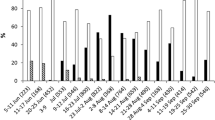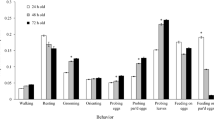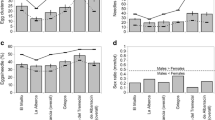Abstract
Egg-laying decisions by female insects should balance aspects related to immature survival and foraging profitability of emerging larvae. Using field-captured individuals, we characterized the egg distribution of Istocheta aldrichi (Diptera: Tachinidae) on the body of its adult host, the Japanese beetle Popillia japonica (Coleoptera: Scarabaeidae). We determined whether the pattern varies as a function of host sex and the number of eggs laid on a given host. Out of the 5667 eggs observed, 95.9% were located on the host pronotum. Furthermore, eggs on the pronotum were mostly positioned in the center of this sclerite and oriented perpendicular to the host body axis. The proportion of eggs placed on other parts of the host body increased with the number of eggs per host (superparasitism). Successful development of I. aldrichi into pupae was maximum for eggs laid on the host pronotum than for eggs laid on other parts of the host. Oviposition decisions in I. aldrichi are likely shaped by trade-offs between vulnerability to grooming by the host and foraging profitability of neonate larvae (i.e., their capacity to penetrate the host cuticle), but also by the mating and defensive behaviors of the Japanese beetle.







Similar content being viewed by others
Data Availability
Full datasets are available in .xlsx format in Supplementary materials 2 (Distribution of I. aldrichi eggs on the host body), 3 (Position and orientation of I. aldrichi eggs on host pronotum) and 4 (Pupation success of I. aldrichi).
References
Abram PK, Guerra-Grenier E, Després-Einspenner ML et al (2015) An insect with selective control of egg coloration. Curr Biol 25:2007–2011
Abram PK, Parent J-P, Miall JH, Mason PG, Brodeur J (2022) Proposed redistribution of Istocheta aldrichii Mesnil (Diptera: Tachinidae) from Ontario and Québec to British Columbia, Canada, for biological control of the Japanese beetle, Popillia japonica Newman (Coleoptera: Scarabaeidae). Report submitted to the BCPPAC for final review, October 20, 2022. https://profils-profiles.science.gc.ca/en/publication/proposed-redistribution-istocheta-aldrichi-mesnil-dipteratachinidae-ontario-and-quebec
Barrows EM, Gordh G (1978) Sexual behavior in the Japanese beetle, Popillia japonica, and comparative notes on sexual behavior of other scarabs (Coleoptera: Scarabaeidae). Behav Biol 23:341–354
Boivin G, Brodeur J (2006) Intra-and interspecific interactions among parasitoids: mechanisms, outcomes and biological control. In: Brodeur J, Boivin G (eds) Trophic and guild interactions in biological control. Springer, Dordrecht, pp 123–144
Chauthani AR, Hamm JJ (1967) Biology of the exotic parasite Drino munda (Diptera: Tachinidae). Ann Entomol Soc Am 60:373–376
Chen J, Li W, Mi Q et al (2020) A newly reported parasitoid, Pentatomophaga latifascia (Diptera: Tachinidae), of adult Halyomorpha halys in Beijing, China. Insects 11:666
Clausen CP, King JL, Teranishi C (1927) The parasites of Popillia japonica in Japan and Chosen (Korea) and their introduction into the United States. United States Department of Agriculture. Department Bulletin No. 1429, Washington, D.C. USA
Commission Delegated Regulation (EU) (2019) 2019/1702 of 1 August 2019 supplementing regulation (EU) 2016/2031 of the European Parliament and of the Council by establishing the list of priority pests. Off J Eur Union 260:8
Danks HV (1975) Factors determining levels of parasitism by Winthemia Rufopicta (Diptera: Tachinidae), with particular reference to Heliothis spp. (Lepidoptera: Noctuidae) as hosts. Can Entomol 107:655–684
Donoughe S (2022) Insect egg morphology: evolution, development, and ecology. Curr Opin Insect Sci 50:100868
Falcon-Brindis A, Stireman JO, Viloria ZJ, Villanueva RT (2022) Parasitism of corn earworm, Helicoverpa zea (Boddie) (Lepidoptera: Noctuidae), by tachinid flies in cultivated hemp. Insects 13:519
Fasano G, Franceschini A (1987) A multidimensional version of the Kolmogorov–Smirnov test. Mon Not R Astron Soc 225:155–170
Feener DH, Brown BV (1993) Oviposition behavior of an ant-parasitizing fly, Neodohrniphora Curvinervis (Diptera: Phoridae), and defense behavior by its leaf-cutting ant host Atta cephalotes (Hymenoptera: Formicidae). J Insect Behav 6:675–688
Fleming WE (1972) Biology of the Japanese beetle. Technical bulletin no. 1449. United States Department of Agriculture
Gagnon M-E, Doyon J, Legault S, Brodeur J (2023) The establishment of the association between the Japanese beetle (Coleoptera: Scarabaeidae) and the parasitoid Istocheta aldrichi (Diptera: Tachinidae) in Québec, Canada. Can Entomol 155:e32
Godfray HCJ (1994) Parasitoids: behavioral and evolutionary ecology. Princeton University Press, Princeton
Harvey JA, Poelman EH, Tanaka T (2013) Intrinsic inter- and intraspecific competition in parasitoid wasps. Annu Rev Entomol 58:333–351
Kelly CD (2020a) Sexual selection on size and shape in Japanese beetles (Popillia japonica). Behav Ecol 31:1073–1083
Kelly CD (2020b) Size and shape assortative mating in Japanese beetles (Popillia japonica). Can J Zool 98:691–695
Ladd TL, Klein MG (1986) Japanese beetle (Coleoptera: Scarabaeidae) response to color traps baited with phenethyl propionate + eugenol + geraniol (3:7:3) and Japonilure. J Econ Entomol 79:84–86
Legault S, Doyon J, Brodeur J (2023) Reliability of a commercial trap to estimate population parameters of Japanese beetles, Popillia japonica, and parasitism by Istocheta aldrichi. J Pest Sci 2004:1–9
Length R (2020) emmeans: Estimated marginal means, aka least-squares means (R package version 1.4.8). Retrieved from https://cran.r-project.org/package=emmeans
Lucas É, Brodeur J (1999) Oviposition site selection by the predatory midge Aphidoletes aphidimyza (Diptera: Cecidomyiidae). Environ Entomol 28:622–627
Murray MD (1961) The ecology of the louse Polyplax serrataq (burn.) On the mouse Mus musculus L. Aust J Zool 9:1–13
Nakamura S (1997) Ovipositional behaviour of the parasitoid fly, Exorista Japonica (Diptera: Tachinidae), in the laboratory: Diel periodicity and egg distribution on a host. Appl Entomol Zool 32:189–195
Puritz C, Ness-Cohn E, Braun R (2021) fasano.franceschini.test. An Implementation of a Multidimensional KS Test in R
Quicke DLJ (1997) Parasitic wasps. Chapman and Hall Ltd
R Core Team (2022) R: a language and environment for statistical computing
Rahman M (1970) Exorista flaviceps, a tachinid parasite of Pieris rapae in South Australia. J Econ Entomol 63:836–841
Schneider CA, Rasband WS, Eliceiri KW (2012) NIH Image to ImageJ: 25 years of image analysis. Nat Methods 9(7):671–675
Shanovich HN, Ribeiro AV, Koch RL (2021) Seasonal abundance, defoliation, and parasitism of Japanese beetle (Coleoptera: Scarabaeidae) in two apple cultivars. J Econ Entomol 114:811–817
Strand MR, Pech LL (2003) Immunological basis for compatibility in parasitoid-host relationships. Annu Rev Entomol 40:31–56
Switzer PV, Enstrom PC, Schoenick CA (2009) Behavioral explanations underlying the lack of trap effectiveness for small-scale management of Japanese beetles (Coleoptera: Scarabaeidae). J Econ Entomol 102:934–940
Tumlinson J, Klein M, Doolittle R et al (1977) Identification of the female Japanese beetle sex pheromone: inhibition of male response by an enantiomer. Science 197:789–792
van Alphen JJM, Visser ME (1990) Superparasitism as an adaptive strategy for insect parasitoids. Annu Rev Entomol 35:59–79
Walker PW, Allen GR (2014) Sex-biased parasitism of adult spring beetles, Heteronyx dimidiata and heteronyx crinitus, by Tachinidae in Eucalyptus nitens plantations in Australia. Austral Entomol 53:104–111
Acknowledgements
We thank the Jardin Botanique de Montréal and Nicolas Pomerleau for allowing us to access sampling sites. We also thank Elisabeth Guillemette, Flavie LeBlanc, Étienne Normandin and Patrick James for technical assistance, and Jeremy N. McNeil and anonymous reviewers for their useful comments regarding an earlier version of this manuscript.
Funding
This work was supported by the Canada research chair in biological control to JB.
Author information
Authors and Affiliations
Contributions
All authors conceptualized and designed the research. SL and JD conducted the field sampling. MP, SL and JD analysed the data. All authors wrote and reviewed the manuscript.
Corresponding author
Ethics declarations
Competing Interests
The authors declare no competing interests.
Additional information
Publisher’s Note
Springer Nature remains neutral with regard to jurisdictional claims in published maps and institutional affiliations.
Electronic Supplementary Material
Below is the link to the electronic supplementary material.
Supplementary Material 1
Rights and permissions
Springer Nature or its licensor (e.g. a society or other partner) holds exclusive rights to this article under a publishing agreement with the author(s) or other rightsholder(s); author self-archiving of the accepted manuscript version of this article is solely governed by the terms of such publishing agreement and applicable law.
About this article
Cite this article
Pelletier, M., Legault, S., Doyon, J. et al. Where and Why do Females of the Parasitic Fly Istocheta aldrichi Lay Their Eggs on the Body of Adult Japanese Beetles?. J Insect Behav 36, 308–317 (2023). https://doi.org/10.1007/s10905-023-09841-8
Received:
Revised:
Accepted:
Published:
Issue Date:
DOI: https://doi.org/10.1007/s10905-023-09841-8




